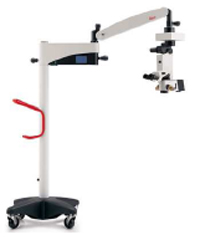New Microscope for Eye Surgery

Although modern medical technology has reduced the time it takes to perform ophthalmic surgery, the workload has steadily increased as more operations are performed per day with less time between cases. To meet the needs of the busy surgical suite, Leica Microsystems has designed the Leica M620 F18, which combines easy set-up and control with high-quality optics, precise illumination, a compact, durable design, at a better price/performance ratio than ever before.
Stable, intensive Red Reflex
Using Leica’s high-precision OptiChrome™ optics and new Direct Halogen Illumination, the surgeon sees a clear, sharply-focused image throughout the entire operation. The sterile jalousie device allows the surgeon to adjust illumination and contrast to the unique physical characteristics of the patient, such as extreme eye pigmentation. The result is completely stable Red Reflex and exceptional intensity.
Full control via touchscreen and user profiles
The logically designed touchscreen is integrated with the stand and clearly displays all settings at a glance to allow fast and easy operation of all microscope controls. User profiles can be programmed for up to four surgeons. Each surgeon can recall his or her individual settings at the press of a button.
Always ready for the next case with Auto Reset
If the Leica M620 F18 is returned to the vertical home position after an operation, the start parameters automatically reset, and the microscope is immediately ready for the next patient. Leica’s Auto Reset function saves valuable time and makes work easier for the entire surgical team. Healthier posture with Leica’s Ergotube Leica has designed the M620 F18 to minimize fatigue because doctors and medical staff spend long working hours at the microscope. Leica’s ergonomic eyetube is designed specifically for cataract surgery and allows a viewing angle of 5 to 25°. If req uired, a co-viewing attachment can be added which rotates along three axes for flexible positioning to give an assistant room to maneuver, even in cramped working conditions.
Smooth movement, easy maneuverability, and long reach
The compact stand and high-quality rollers ensure smooth movement and easy maneuverability. With the long-reach swingarm, the Leica M620 F18 can easily be positioned in the operating room. Using a video adapter such as the Leica Video Zoom Adapter, any video system can be connected to the beamsplitter for documenting and archiving the images. Additional accessories, e.g., for observing the retina or laser filters, easily integrate with the system. Leica Microsystems offers a wide range of binocular tubes and objectives to offer a microscope configuration to fit every individual surgeon’s needs.
Leica Microsystems is a leading global designer and producer of innovative, high-tech, precision optical systems for the analysis of microstructures. It is one of the market leaders in each of its business areas: Microscopy, Confocal Laser Scanning Microscopy, Imaging Systems, Specimen Preparation and Medical Equipment. The company manufactures a broad range of products for numerous applications requiring microscopic imaging, measurement, and analysis. It also offers system solutions for life science including biotechnology and medicine, research and development of raw materials, and industrial quality assurance. The company is represented in over 100 countries with 8 manufacturing facilities in 6 countries, sales and service organizations in 19 countries and an international network of dealers. With its workforce of about 3,200 employees it made turnover of US$ 597m in 2005. The international management is headquartered in Wetzlar, Germany.
Media Contact
More Information:
http://www.leica-microsystems.com/Surgical_MicroscopesAll latest news from the category: Medical Engineering
The development of medical equipment, products and technical procedures is characterized by high research and development costs in a variety of fields related to the study of human medicine.
innovations-report provides informative and stimulating reports and articles on topics ranging from imaging processes, cell and tissue techniques, optical techniques, implants, orthopedic aids, clinical and medical office equipment, dialysis systems and x-ray/radiation monitoring devices to endoscopy, ultrasound, surgical techniques, and dental materials.
Newest articles

First-of-its-kind study uses remote sensing to monitor plastic debris in rivers and lakes
Remote sensing creates a cost-effective solution to monitoring plastic pollution. A first-of-its-kind study from researchers at the University of Minnesota Twin Cities shows how remote sensing can help monitor and…

Laser-based artificial neuron mimics nerve cell functions at lightning speed
With a processing speed a billion times faster than nature, chip-based laser neuron could help advance AI tasks such as pattern recognition and sequence prediction. Researchers have developed a laser-based…

Optimising the processing of plastic waste
Just one look in the yellow bin reveals a colourful jumble of different types of plastic. However, the purer and more uniform plastic waste is, the easier it is to…



